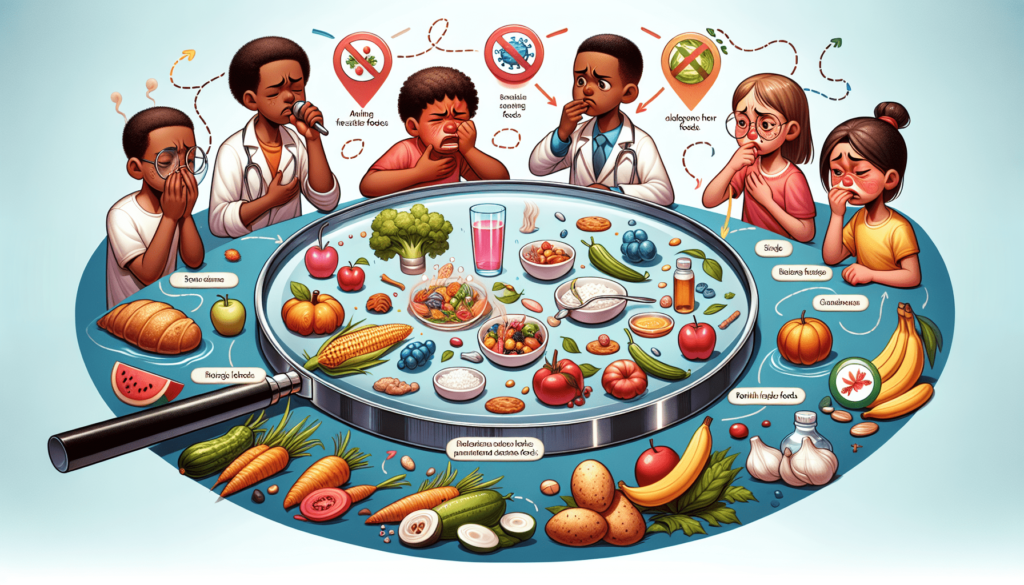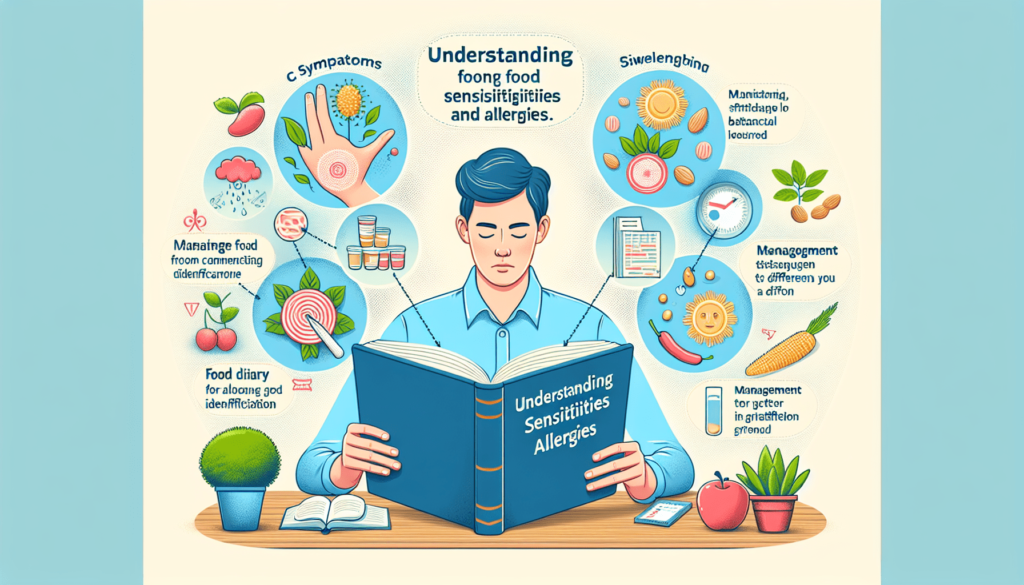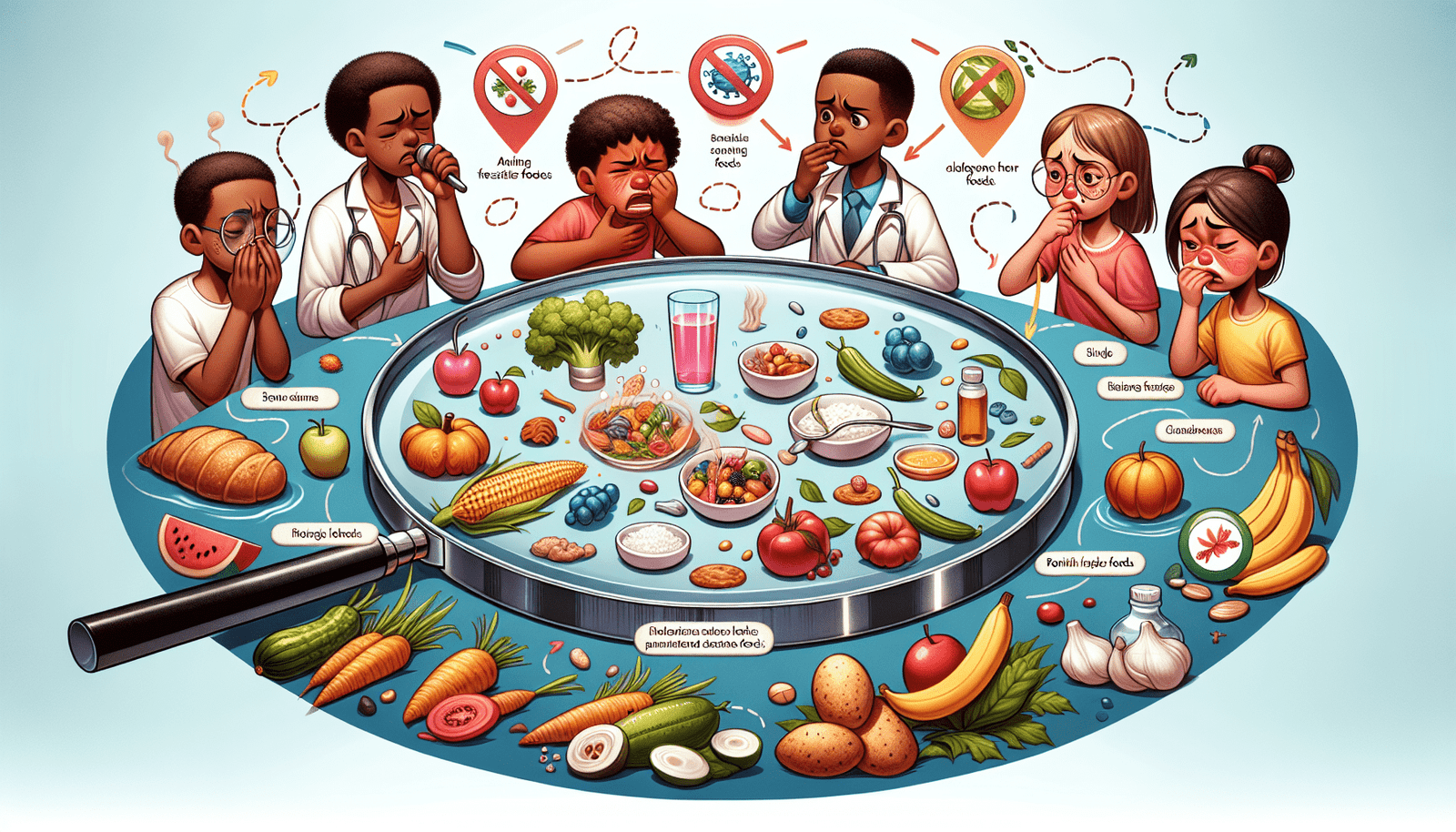Have you ever experienced an upset stomach or a skin rash after eating certain foods? If so, you may have a food sensitivity or allergy. In this article, we will explore the fascinating world of food sensitivities and allergies, helping you gain a better understanding of the potential triggers, symptoms, and management strategies. From gluten and dairy to nuts and shellfish, discover how these sensitivities and allergies can vary in severity and impact your daily life. By the end of this article, you will be equipped with knowledge to help you navigate food choices and establish a healthy relationship with the food you eat.
What are food sensitivities and allergies?
Definition of food sensitivities
Food sensitivities, also known as food intolerances, refer to the adverse reactions that occur after consuming certain foods. These reactions are usually triggered by a difficulty in digesting specific components of the food, such as lactose or gluten. Food sensitivities can result in uncomfortable symptoms, but they are not typically life-threatening.
Definition of food allergies
Food allergies, on the other hand, are immune-mediated responses to certain proteins present in food. When someone with a food allergy comes into contact with their allergenic food, their immune system identifies it as a threat and releases chemicals that cause various symptoms. Food allergies can range from mild to severe, and in some cases, they can lead to a life-threatening reaction known as anaphylaxis.
Difference between food sensitivities and allergies
The main distinction between food sensitivities and allergies lies in the immune response they trigger. Food sensitivities are primarily digestive in nature, causing symptoms such as bloating, gas, or diarrhea. In contrast, food allergies involve the immune system and can cause a wide range of symptoms affecting different parts of the body, including the skin, respiratory system, or cardiovascular system. While food sensitivities may be uncomfortable, food allergies can be more severe and potentially life-threatening.
Common food allergens
When it comes to food allergens, certain types of foods are more likely to cause allergic reactions than others. Here are some common food allergens:
Peanuts
Peanut allergy is one of the most prevalent and potentially severe food allergies. Even a tiny amount of peanuts or peanut protein can trigger a reaction in individuals with this allergy.
Tree nuts
Tree nuts like almonds, cashews, and walnuts are also common allergens. People who are allergic to one type of tree nut tend to be allergic to others as well.
Milk
Milk allergy is more common in children and is often outgrown by adulthood. Allergic reactions to milk can range from mild to severe.
Eggs
Egg allergies are more common in children but can also affect adults. Reactions to eggs can vary, with some individuals reacting to the egg white and others to the yolk.
Fish
Fish allergies can develop during childhood or adulthood and are often lifelong. Both saltwater and freshwater fish can trigger allergic reactions.
Shellfish
Shellfish allergies are among the most common food allergies in adults. Allergic reactions can occur to crustaceans like shrimp, lobster, and crab, as well as mollusks like clams and mussels.
Wheat
Wheat allergy is more common in children and is usually outgrown by adulthood. It is distinct from gluten sensitivity or celiac disease.
Soy
Soy allergies can affect both children and adults. Soy is a common ingredient in many processed foods, making it important to read labels carefully.
Sesame seeds
Allergic reactions to sesame seeds are becoming more prevalent. Sesame can be found in various foods, including bread, sauces, and condiments.
It is essential to note that these are not the only allergenic foods, and individuals can be allergic to other foods as well. It is crucial for individuals with known food allergies or sensitivities to avoid consumption of these allergens to prevent a reaction.

Symptoms of food sensitivities and allergies
The symptoms of food sensitivities and allergies can vary greatly depending on the individual and the specific allergen involved. Here are some common symptoms associated with food sensitivities and allergies:
Digestive symptoms
Digestive symptoms are often seen in individuals with food sensitivities or intolerances. These may include bloating, gas, abdominal pain, nausea, vomiting, or diarrhea. In some cases, food sensitivities can also trigger conditions like irritable bowel syndrome (IBS).
Respiratory symptoms
Respiratory symptoms can range from mild to severe and may include sneezing, a runny or stuffy nose, watery eyes, coughing, wheezing, or difficulty breathing. These symptoms are usually associated with food allergies and can be a result of the allergen being inhaled or ingested.
Skin symptoms
Skin symptoms are particularly common in food allergies and can manifest as hives, itching, swelling, or eczema. Some individuals may also experience a more severe allergic reaction known as angioedema, which involves swelling beneath the skin.
Cardiovascular symptoms
Certain food allergies can affect the cardiovascular system, leading to symptoms such as a rapid or irregular heartbeat, low blood pressure, dizziness, or fainting. These symptoms can be a sign of a severe allergic reaction, including anaphylaxis, which requires immediate medical attention.
Other symptoms
In addition to the symptoms mentioned above, food sensitivities and allergies can also cause a range of other symptoms. These may include headaches, fatigue, joint pain, mood changes, or difficulty concentrating. It is important to note that these symptoms can be non-specific and may vary in severity.
How are food sensitivities and allergies diagnosed?
Proper diagnosis of food sensitivities and allergies is crucial for effective management and prevention of potential reactions. Here are some common methods used to diagnose these conditions:
Medical history and physical examination
The first step in diagnosing food sensitivities and allergies is taking a detailed medical history. Your healthcare provider will ask about your symptoms, their frequency and duration, and any potential triggers. They may also perform a physical examination to look for signs of allergic reactions.
Skin prick test
A skin prick test involves placing a small amount of allergenic food extract on your skin and then gently pricking or scratching the area. If you are allergic to that specific food, you may develop a raised bump or a red and itchy rash at the test site.
Blood tests
Blood tests, such as the specific IgE test or the component-resolved diagnostics, can measure the levels of specific antibodies related to allergies. These tests can help identify potential allergens responsible for your symptoms.
Oral food challenge
An oral food challenge involves consuming small doses of the suspected allergenic food under medical supervision. This is done to observe if any symptoms develop. It is considered the gold standard for confirming a food allergy diagnosis.
Elimination diet
An elimination diet involves removing specific foods or food groups from your diet to see if your symptoms improve. If your symptoms resolve during the elimination phase and return when you reintroduce the eliminated food, it can indicate a food sensitivity or allergy.

Prevalence of food sensitivities and allergies
Understanding the prevalence of food sensitivities and allergies is essential for public health efforts and healthcare planning. Here are some statistics related to these conditions:
Statistics on food sensitivities
It is estimated that around 10-20% of the population may have food sensitivities or intolerances. The most common food sensitivities are lactose intolerance, gluten sensitivity, and sensitivity to certain FODMAPs (fermentable oligosaccharides, disaccharides, monosaccharides, and polyols).
Statistics on food allergies
Food allergies are believed to affect approximately 5-8% of children and 3-4% of adults. The most prevalent food allergies in children are to milk, eggs, peanuts, and tree nuts. In adults, common food allergies include shellfish, fish, peanuts, and tree nuts.
Changing trends in prevalence
The prevalence of food sensitivities and allergies appears to be increasing worldwide. The reasons for this increase are not entirely understood, but factors such as changes in diet, environmental exposures, and genetic predisposition may all play a role. Continued research is needed to further understand these trends and their underlying causes.
Causes of food sensitivities and allergies
The development of food sensitivities and allergies is influenced by various factors. Here are some potential causes:
Genetic factors
There is a genetic component to food sensitivities and allergies. Individuals with a family history of allergies are more likely to develop allergies themselves. However, it is important to note that genetics alone do not fully explain the development of these conditions.
Environmental factors
Environmental factors, such as exposure to allergens and pollutants, may contribute to the development of food sensitivities and allergies. Early exposure to potential allergens, especially during infancy, may help prevent the development of allergies.
Early exposure to allergenic foods
Introducing allergenic foods to infants early in life, under medical supervision, may help decrease the risk of developing certain allergies. This approach is known as early allergen introduction and has shown promise in reducing food allergy rates.
Hygiene hypothesis
The hygiene hypothesis suggests that living in an overly clean environment with limited exposure to microbes may increase the risk of developing allergies. Lack of early childhood exposure to bacteria and viruses may affect immune system development and make individuals more susceptible to food sensitivities and allergies.
Managing food sensitivities and allergies
Managing food sensitivities and allergies involves strategies to prevent accidental exposure to allergens and minimize the risk of reactions. Here are some essential management techniques:
Avoidance of allergenic foods
The primary approach to managing food allergies is to avoid allergenic foods altogether. This requires careful reading of food labels and being vigilant about cross-contamination in food preparation.
Reading food labels
When living with food sensitivities or allergies, it is crucial to read food labels thoroughly. Look for potential allergens hidden in ingredient lists and be aware of labeling laws that require food manufacturers to clearly state common allergens.
Cross-contamination prevention
Cross-contamination can occur when allergenic foods come into contact with other foods or surfaces during preparation. It is important to have dedicated kitchen utensils, cutting boards, and cookware to prevent cross-contamination.
Educating oneself and others
It is essential to educate yourself, friends, family, and caregivers about food sensitivities and allergies. Teach them about allergens to look out for, symptoms of reactions, and how to respond in case of an emergency.
Emergency management
Individuals with severe food allergies should always carry an epinephrine auto-injector (such as an EpiPen). In case of anaphylaxis, immediate administration of epinephrine and seeking medical attention is crucial.
Treatment options for food sensitivities and allergies
While there is no cure for food sensitivities or allergies, various treatment options can help manage symptoms and reduce the risk of reactions. Here are some common treatment approaches:
Medications
Antihistamines can help alleviate mild allergic symptoms, such as itching or hives. In certain cases, corticosteroids may be prescribed to reduce inflammation and manage more severe symptoms. However, medications only provide temporary relief and do not address the underlying allergy.
Epinephrine auto-injectors
Epinephrine auto-injectors, like the EpiPen, are potentially life-saving devices. These injectors contain epinephrine (adrenaline), which can quickly reverse the symptoms of anaphylaxis. They should be used immediately in the event of a severe allergic reaction and followed by immediate medical attention.
Immunotherapy
Immunotherapy, such as allergy shots or sublingual immunotherapy, involves gradually exposing the body to small amounts of the allergenic protein to build tolerance over time. These treatments are typically reserved for severe allergies and are performed under medical supervision.
Alternative approaches
Some individuals explore alternative approaches for managing food sensitivities and allergies, such as acupuncture, herbal remedies, or dietary supplements. While these approaches may provide relief for some individuals, it is important to consult with healthcare professionals before trying them.
Impact of food sensitivities and allergies on quality of life
Living with food sensitivities and allergies can significantly impact an individual’s quality of life. Here are some ways these conditions can impact various aspects of life:
Physical impact
Food sensitivities and allergies can cause unpleasant physical symptoms, which can range from minor discomfort to severe and life-threatening reactions. These symptoms can interfere with daily activities and lead to limitations in food choices.
Psychological impact
Managing food sensitivities and allergies can be mentally challenging. The fear of accidental exposure or reactions can cause anxiety, stress, and social isolation. Coping with the emotional aspects of living with these conditions is also important.
Social and emotional impact
Food sensitivities and allergies can affect social interactions and relationships, particularly in social settings that revolve around food. Individuals may feel left out or different, and the need to constantly explain their dietary restrictions can be emotionally taxing.
Financial impact
The cost of managing food sensitivities and allergies can be significant. Safe and allergen-free foods may be more expensive, and medical expenses related to diagnosis and treatment can add up. This financial burden can further contribute to the overall impact on an individual’s quality of life.
Future directions in food sensitivities and allergies research
Ongoing research aims to better understand and address the challenges associated with food sensitivities and allergies. Here are some areas of focus for future research:
Advancements in diagnosis methods
Improving the accuracy and availability of diagnostic methods for food sensitivities and allergies is a priority. This includes developing new tests and technologies that can provide quicker and more reliable results.
Development of targeted therapies
Researchers are exploring novel treatment options to specifically target the underlying mechanisms involved in food allergies. This includes investigating approaches like oral immunotherapy, biologic drugs, and gene therapies.
Prevention strategies
Efforts to prevent food sensitivities and allergies are gaining attention. These strategies include exploring early allergen introduction, studying optimal dietary approaches during pregnancy and infancy, and investigating the potential benefits of probiotics and other interventions.
Exploration of the gut microbiome
Research is focusing on the role of the gut microbiome in food sensitivities and allergies. Understanding how the gut bacteria influence immune system development and response may lead to new approaches for prevention and management.
In conclusion, food sensitivities and allergies are significant health concerns affecting individuals worldwide. They can cause a wide range of symptoms and can significantly impact quality of life. Proper diagnosis, management strategies, and ongoing research efforts are essential for improving the lives of those living with these conditions. With increased awareness and community support, individuals with food sensitivities and allergies can thrive and enjoy a safe and fulfilling life.

